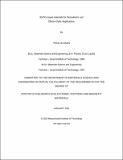| dc.contributor.advisor | Harry L. Tuller. | en_US |
| dc.contributor.author | Avrahami, Ytshak, 1969- | en_US |
| dc.contributor.other | Massachusetts Institute of Technology. Dept. of Materials Science and Engineering. | en_US |
| dc.date.accessioned | 2005-05-17T14:59:18Z | |
| dc.date.available | 2005-05-17T14:59:18Z | |
| dc.date.copyright | 2003 | en_US |
| dc.date.issued | 2003 | en_US |
| dc.identifier.uri | http://hdl.handle.net/1721.1/16702 | |
| dc.description | Thesis (Ph. D.)--Massachusetts Institute of Technology, Dept. of Materials Science and Engineering, 2003. | en_US |
| dc.description | Includes bibliographical references (p. 93-95). | en_US |
| dc.description | This electronic version was submitted by the student author. The certified thesis is available in the Institute Archives and Special Collections. | en_US |
| dc.description.abstract | Ferroelectric materials are key to many modem technologies, in particular piezoelectric actuators and electro-optic modulators. BaTiO₃ is one of the most extensively studied ferroelectric materials. The use of BaTiO₃ for piezoelectric applications is, however, limited due to the small piezoelectric coefficient of the room temperature-stable tetragonal phase. Furthermore, research on BaTiO₃ for integrated optics applications remains sparse. In this work Zr-, Hf-, and KNb- doped BaTiO₃ materials were prepared in a composition range that stabilizes the rhombohedral phase. These materials were prepared as bulk polycrystals using a standard solid-state reaction technique in order to test the piezoelectric and dielectric properties. Some compositions were then chosen for thin film deposition. The films were deposited using pulsed laser deposition on MgO and SOI substrates. Growth orientation, remnant strain and optical properties were then measured. X-ray diffraction was used to confirm the existence of a stable rhombohedral phase. Dielectric measurements confirmed the expected phase transition temperatures. A piezoelectric coefficient of d₃₃=290-470pc/N was measured for Zr- and Hf- doped BaTiO₃, compared with d₃₃=75pC/N for pure BaTiO₃. The electrostrictive coefficient of the KNb-doped material, was measured as Q33=0.37m⁴/C², compared with Q33=0.11m⁴/C² for pure BaTiO₃. The maximum strain measured for the doped samples was 5-10 times higher then that of pure BaTiO₃. The effect of growth conditions on the orientation and strain of BaTiO₃ thin films was studied. As the substrate temperature and laser fluency were increased the film orientation varied from (111) to (110), then to (100). Zr- and Hf- doping helped lower the forming temperature for the | en_US |
| dc.description.abstract | (cont.) orientations. The index of refraction for the thin films was measured and a model based on the Clausius-Mossotti relation was used to explain the data. The refractive index for BaTiO₃ films was extracted from the model, giving n=2.334 and n,=2.163. | en_US |
| dc.description.statementofresponsibility | by Ytshak Avrahami. | en_US |
| dc.format.extent | 95 p. | en_US |
| dc.format.extent | 1742528 bytes | |
| dc.format.extent | 1749399 bytes | |
| dc.format.mimetype | application/pdf | |
| dc.format.mimetype | application/pdf | |
| dc.language.iso | eng | en_US |
| dc.publisher | Massachusetts Institute of Technology | en_US |
| dc.rights | M.I.T. theses are protected by copyright. They may be viewed from this source for any purpose, but reproduction or distribution in any format is prohibited without written permission. See provided URL for inquiries about permission. | en_US |
| dc.rights.uri | http://dspace.mit.edu/handle/1721.1/7582 | |
| dc.subject | Materials Science and Engineering. | en_US |
| dc.title | BaTiO₃ based materials for piezoelectric and electro-optic applications | en_US |
| dc.type | Thesis | en_US |
| dc.description.degree | Ph.D. | en_US |
| dc.contributor.department | Massachusetts Institute of Technology. Department of Materials Science and Engineering | |
| dc.identifier.oclc | 57518912 | en_US |
